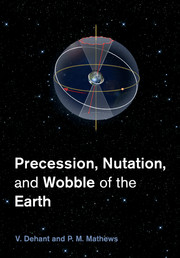Book contents
- Frontmatter
- Contents
- Preface
- List of abbreviations
- 1 Introduction – Fundamental definitions – Motivation
- 2 Concepts and elementary theory
- 3 Reference systems and frames
- 4 Observational techniques – ephemerides
- 5 Rigid Earth precession and nutation
- 6 Deformable Earth – Love numbers
- 7 Nutations of a non-rigid Earth
- 8 Anelasticity
- 9 Ocean and atmospheric corrections
- 10 Refinements of non-rigid nutation
- 11 Comparison observation-theory
- 12 Conventions
- 13 Mars nutations
- Appendix A Rotation representation
- Appendix B Clairaut theory
- Appendix C Definitions of equinoxes
- Bibliography
- Index
1 - Introduction – Fundamental definitions – Motivation
Published online by Cambridge University Press: 05 May 2015
- Frontmatter
- Contents
- Preface
- List of abbreviations
- 1 Introduction – Fundamental definitions – Motivation
- 2 Concepts and elementary theory
- 3 Reference systems and frames
- 4 Observational techniques – ephemerides
- 5 Rigid Earth precession and nutation
- 6 Deformable Earth – Love numbers
- 7 Nutations of a non-rigid Earth
- 8 Anelasticity
- 9 Ocean and atmospheric corrections
- 10 Refinements of non-rigid nutation
- 11 Comparison observation-theory
- 12 Conventions
- 13 Mars nutations
- Appendix A Rotation representation
- Appendix B Clairaut theory
- Appendix C Definitions of equinoxes
- Bibliography
- Index
Summary
Rotation and global shape of the Earth
At a very elementary level, the Earth is considered to be an axially symmetric ellipsoid, rotating with uniform angular speed about its symmetry axis, which is the polar axis passing through the Earth's center and its north and south poles; under the steady rotation, the direction of this axis maintains a fixed direction in space, i.e., relative to the directions of the “fixed stars.” (The celestial objects that come closest to the ideal of remaining “fixed in space” are the quasars, the most distant extragalactic celestial objects.) The direction of the symmetry axis is at an inclination of about 23.5° to the direction of the normal to the plane of the Earth's orbit around the Sun (or more precisely, about the solar system barycenter, i.e. the center of mass of the solar system).
An axially symmetric ellipsoidal shape, bulging at the equator and flattened at the poles, and an internal structure with the same symmetry, would result from the centrifugal force associated with uniform Earth rotation around the polar axis, counterbalanced by gravity. The ellipsoidal structure computed on the basis of this balance of forces, assuming that the material of the rotating body behaves like a fluid under the incessant action of forces acting over very long timescales (i.e., that the resistance of even solid regions to shear deformation is overcome under such conditions), is called the “hydrostatic equilibrium ellipsoid.” The Earth's figure (shape) does conform quite closely, though not perfectly, to that of such an ellipsoid. The equatorial radius of the Earth exceeds the polar radius by about 21 km; this is often described as the equatorial bulge. This bulge is to be viewed in relation to the mean radius of about 6371 km.
Orbit of the Earth
The force of gravitational attraction of the Sun on the total mass of the Earth holds the Earth in orbital motion around the Sun; similarly, the Earth’s gravitational force maintains the orbital motion of the Moon around the Earth.
- Type
- Chapter
- Information
- Precession, Nutation and Wobble of the Earth , pp. 1 - 11Publisher: Cambridge University PressPrint publication year: 2015



